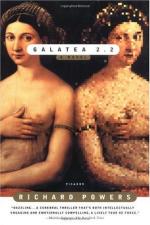|
This section contains 154 words (approx. 1 page at 300 words per page) |

|
Powers' simmediate and most obvious literary debt in Galatea 2.2 is to Roman mythology, notably to Ovid's Metamorphoses, completed probably in the first decade of the common era, which recounts the Pygmalion-Galatea story in some detail. Although the mythological story of Pygmalion's Galatea is an underlying current in Powers's novel, the book is connected less directly with this myth than were Jacinto Grau's Pygmalion (1930), George Bernard Shaw's Pygmalion (1913), or Alan Jay Lerner and Frederick Loewe's adaptation of the Shaw play, My Fair Lady (1956).
The myth has long intrigued authors, among them John Lyly, whose Galathea (1592) was based on the legend, and Francis Beaumont and John Fletcher, whose Philaster (1611) centers on the myth. In Spain, Miguel de Cervantes' novel, La Galatea (1585) was based on the classical account. In the first quarter of the seventeenth century, the Spanish poet Luis de Gongora y Argote wrote "Polyphnemus and Galatea," also...
|
This section contains 154 words (approx. 1 page at 300 words per page) |

|




